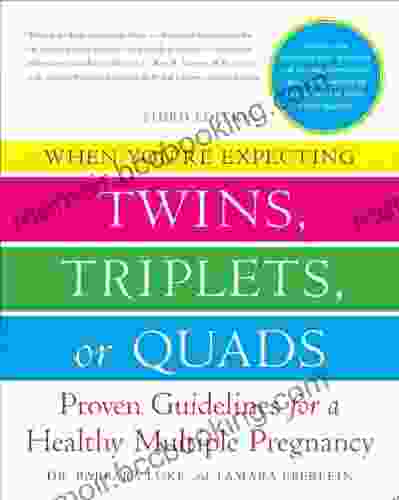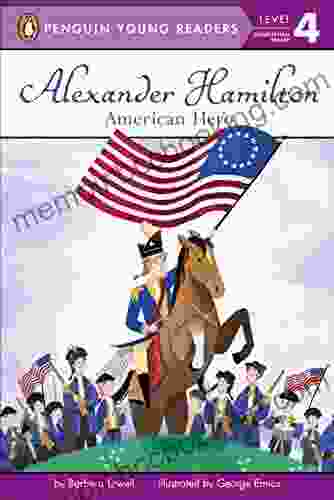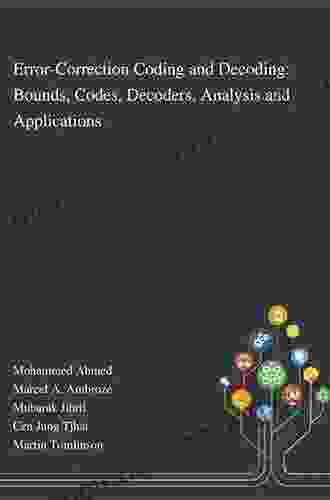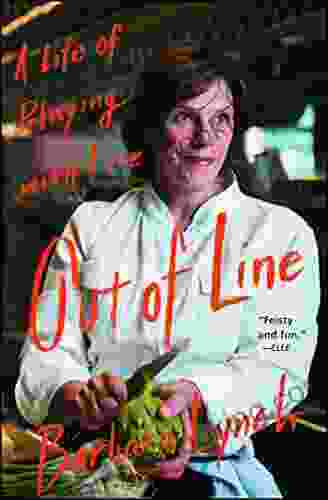Error Correction Coding and Decoding: Unlocking the Secrets of Reliable Communication

In an increasingly digital world, where data is transmitted and stored in vast quantities, the need for reliable communication is paramount. Imagine sending a critical email only for it to arrive corrupted or distorted, leading to misunderstandings or even catastrophic consequences.
To address this challenge, error correction coding (ECC) emerged as a groundbreaking technology that ensures the integrity of data, safeguarding it from errors that may occur during transmission or storage. This article delves into the fascinating world of ECC, exploring its principles, applications, and the ingenious techniques used to correct errors and enhance data reliability.
4.3 out of 5
| Language | : | English |
| File size | : | 38443 KB |
| Text-to-Speech | : | Enabled |
| Screen Reader | : | Supported |
| Enhanced typesetting | : | Enabled |
| Print length | : | 860 pages |
Shannon's Theorem: The Birth of ECC
The theoretical foundation of ECC lies in Shannon's theorem, proposed by Claude Shannon in 1948. This seminal work established the limits of reliable communication, demonstrating that it is possible to transmit data over a noisy channel with an arbitrarily low probability of error, provided that the rate of transmission is below the channel's capacity.
Shannon's theorem sparked a revolution in communication theory, inspiring researchers to develop practical coding techniques that could approach this theoretical limit. These techniques, collectively known as ECC codes, have become an indispensable part of modern communication systems.
Types of ECC Codes
There is a wide range of ECC codes, each tailored to specific applications. Some of the most commonly used types include:
- Convolutional codes: These are powerful codes that offer continuous error correction, making them suitable for real-time applications such as digital video streaming and wireless communication.
- Turbo codes: Derived from convolutional codes, turbo codes provide exceptional performance even at low signal-to-noise ratios. They are employed in high-speed data transmission systems, such as 4G/5G mobile networks and satellite communication.
- LDPC (Low-Density Parity-Check) codes: LDPC codes are a class of advanced codes that offer near-capacity performance. They are particularly effective in large data storage systems, such as hard disk drives and solid-state drives.
Applications of ECC
ECC finds applications in numerous domains, including:
- Data transmission: ECC ensures the reliability of data transmitted over noisy channels, such as wireless networks, fiber optic cables, and satellite links.
- Data storage: ECC protects stored data from errors caused by media defects, power outages, and other environmental factors.
- Digital communication: ECC is essential in digital communication systems, such as modems, routers, and smartphones, to maintain the integrity of data.
- Industrial control systems: ECC is crucial in critical applications where reliable communication is paramount, such as in power plants, manufacturing facilities, and transportation systems.
Decoding Techniques
Decoding is the process of recovering the original data from an encoded message that may have errors. There are several decoding techniques, each with its strengths and weaknesses:
- Hard decoding: This method treats each received bit as either correct or incorrect, making it suitable for simple codes and high signal-to-noise ratios.
- Soft decoding: This technique exploits the soft information available in modern communication systems to improve decoding performance, especially at low signal-to-noise ratios.
- Iterative decoding: This powerful approach involves multiple rounds of decoding, allowing the decoder to refine its estimates of the original data.
Error correction coding and decoding are fundamental technologies that have revolutionized modern communication. By combating errors and ensuring data integrity, ECC enables reliable and efficient data transmission and storage. From wireless networks to data centers and industrial control systems, ECC plays a vital role in shaping the digital world of today and tomorrow.
For those seeking a comprehensive understanding of ECC, the book "Error Correction Coding and Decoding" provides an in-depth exploration of the theory, techniques, and applications of this essential technology. This book is an invaluable resource for students, researchers, and practitioners in the fields of communication engineering, computer science, and information theory.
4.3 out of 5
| Language | : | English |
| File size | : | 38443 KB |
| Text-to-Speech | : | Enabled |
| Screen Reader | : | Supported |
| Enhanced typesetting | : | Enabled |
| Print length | : | 860 pages |
Do you want to contribute by writing guest posts on this blog?
Please contact us and send us a resume of previous articles that you have written.
 Book
Book Novel
Novel Page
Page Chapter
Chapter Text
Text Story
Story Genre
Genre Reader
Reader Library
Library Paperback
Paperback E-book
E-book Magazine
Magazine Newspaper
Newspaper Paragraph
Paragraph Sentence
Sentence Bookmark
Bookmark Shelf
Shelf Glossary
Glossary Bibliography
Bibliography Foreword
Foreword Preface
Preface Synopsis
Synopsis Annotation
Annotation Footnote
Footnote Manuscript
Manuscript Scroll
Scroll Codex
Codex Tome
Tome Bestseller
Bestseller Classics
Classics Library card
Library card Narrative
Narrative Biography
Biography Autobiography
Autobiography Memoir
Memoir Reference
Reference Encyclopedia
Encyclopedia Baby Darling
Baby Darling Alison Weir
Alison Weir Audrey J Cole
Audrey J Cole Barbara Ann Kipfer
Barbara Ann Kipfer Annie Anderson
Annie Anderson B Matthew
B Matthew Ariana Dimitrakis
Ariana Dimitrakis Arun Jagannathan
Arun Jagannathan Augustus Numley
Augustus Numley Augusto Boal
Augusto Boal Barb Asselin
Barb Asselin Arnold Stead
Arnold Stead Barbara Hambly
Barbara Hambly Anton Angelov
Anton Angelov Ann Rhoades
Ann Rhoades Anthony Summers
Anthony Summers Aram Attarian
Aram Attarian Ansel Adams
Ansel Adams Asti Hustvedt
Asti Hustvedt Ann Spencer
Ann Spencer
Light bulbAdvertise smarter! Our strategic ad space ensures maximum exposure. Reserve your spot today!

 Alexandre DumasUnlock the Secrets of Photography: A Comprehensive Guide to Viewpoints and...
Alexandre DumasUnlock the Secrets of Photography: A Comprehensive Guide to Viewpoints and...
 Tom ClancyUnravel the Secrets of 'An Arranged Marriage Mafia Romance Mafia Misfits' - A...
Tom ClancyUnravel the Secrets of 'An Arranged Marriage Mafia Romance Mafia Misfits' - A... Phil FosterFollow ·19.4k
Phil FosterFollow ·19.4k Blake KennedyFollow ·8.7k
Blake KennedyFollow ·8.7k Finn CoxFollow ·6.7k
Finn CoxFollow ·6.7k Eric HayesFollow ·13.9k
Eric HayesFollow ·13.9k Ruben CoxFollow ·11.6k
Ruben CoxFollow ·11.6k Banana YoshimotoFollow ·4.8k
Banana YoshimotoFollow ·4.8k Clayton HayesFollow ·9k
Clayton HayesFollow ·9k Pete BlairFollow ·12k
Pete BlairFollow ·12k

 Brayden Reed
Brayden ReedTeach Your Child They Have No Self Worth And They Will...
By Dr. Jane Doe ...

 Shawn Reed
Shawn ReedUnveiling Centuries of Tradition: History of Childbirth...
Journey into the heart of the...

 Brady Mitchell
Brady MitchellProven Guidelines For Healthy Multiple Pregnancy
Congratulations on your...

 Dylan Mitchell
Dylan MitchellHarness the Power of Sleep for Optimal Health and...
In the fast-paced,...

 Herman Melville
Herman MelvilleAlexander Hamilton: The Revolutionary Who Shaped...
Alexander Hamilton was a...
4.3 out of 5
| Language | : | English |
| File size | : | 38443 KB |
| Text-to-Speech | : | Enabled |
| Screen Reader | : | Supported |
| Enhanced typesetting | : | Enabled |
| Print length | : | 860 pages |










